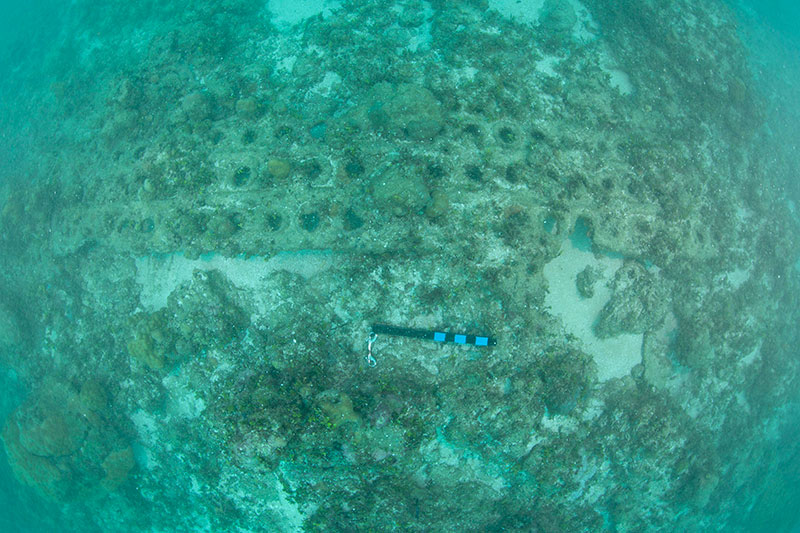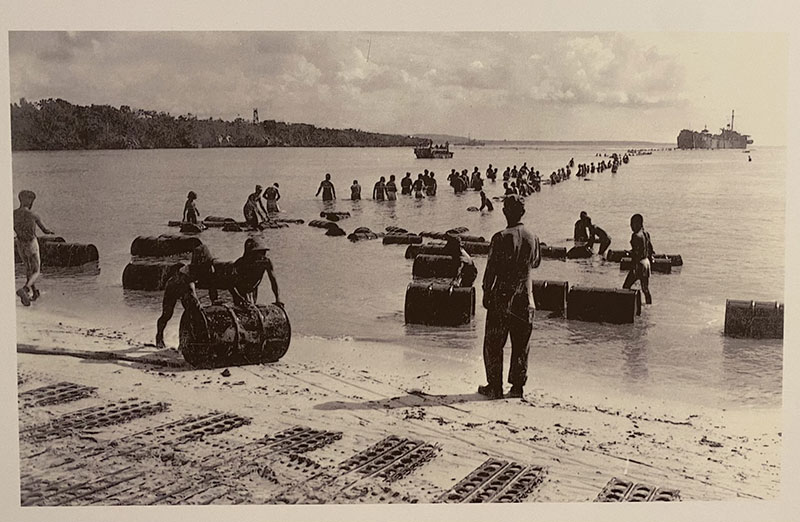Guam: A Biogeographic and Maritime Cultural Landscape Exploration of a World War II Amphibious Battlefield
January 27-February 25, 2023 // July 27-August 23, 2023
Project Findings Once "Paved" the Way for Invasion
While investigating previously identified side-scan sonar and magnetometer targets in the waters off Guam's World War II (WWII) landing beaches, technical divers from the National Park Service Submerged Resources Center and the NOAA Diving Program discovered five sections of pierced steel planking (PSP), also known as "Marston mats," off Agat beach.

Other dive targets were identified as unexploded ordnance from World War II, including .30-06 rifle rounds (30 caliber), 60 millimeter mortars, and larger artillery rounds. In 1945, American troops discarded much of this ordnance beneath the waves of what is now War in the Pacific National Historical Park in an effort to clean up after the war's conclusion. Disappointingly, some of the targets turned out to be storm debris, small vessel anchors, and discarded pipes that had washed out to sea.
The PSP was certainly among the more exciting discoveries. Even though it's a relatively common repurposed material in the Pacific today and many people are familiar with it, details about its origin, purpose, and legacy are not widely known.
PSP was first tested in Marston, North Carolina, prior to the United States entering WWII; it's from this community that PSP got its nickname. PSP quickly became the go-to tool of the Navy Seabees (the U.S. Naval Construction Battalions) for getting crucial equipment, infrastructure, personnel, and supplies on and off WWII battlefields. When deployed, the interlocking planks (each plank was 10 feet long and 15 inches wide) created a hard, corrosion-resistant surface, allowing them to stabilize sandy beaches quickly and efficiently to move heavy equipment, unload supplies, and rapidly construct airfields and roadways. By the end of WWII, Seabee engineers and crews were able to clear, grade, plank, and complete a 3,000 foot runway in less than 72 hours.

The distinctive design featuring flared, pierced holes — 3 holes wide by 29 holes long — gave the planks a recognizable aesthetic. More importantly, these holes allowed water to drain off the surface of the planks, provided traction to prevent slipping, and let vegetation, especially grasses, recolonize cleared areas of land, preventing puddles and rutting, securing soils from erosion, and reducing airborne dust and sand. PSP was also lighter than other mats of the time, so fewer personnel were needed to deploy it, and the prefabricated sections nested neatly into one another, requiring less cargo space on ships.
The usefulness of PSP on the sandy, rain-soaked Pacific Islands, more so than anywhere else, cannot be overstated.
Of the millions of pieces of PSP manufactured and deployed across the globe between 1941 and 1945, a handful remain offshore of Guam’s Agat Beach and serve as reminders of this relatively simple and versatile yet important invention that allowed U.S. forces to move mountains of equipment, countless tons of vehicles, and thousands of troops with minimum effort and maximum speed.
By Matthew Hanks, National Park Service Submerged Resources Center
Published August 31, 2023